
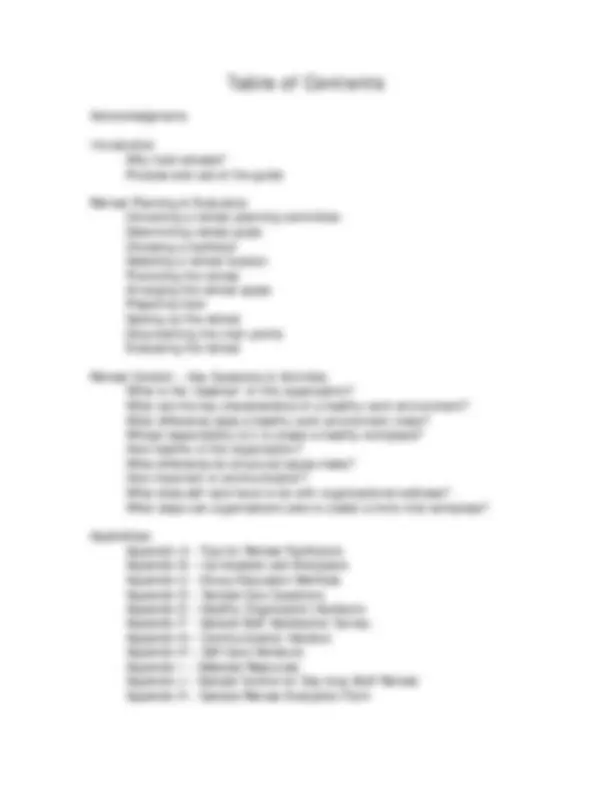
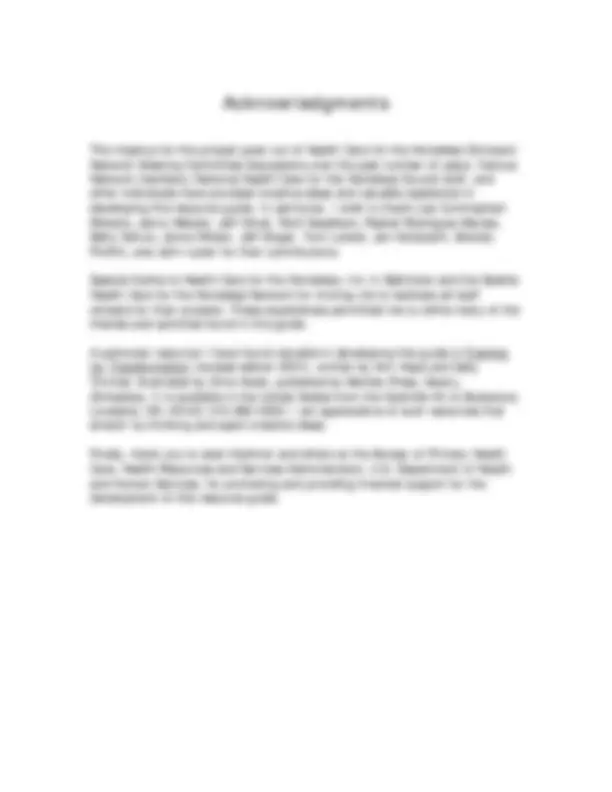
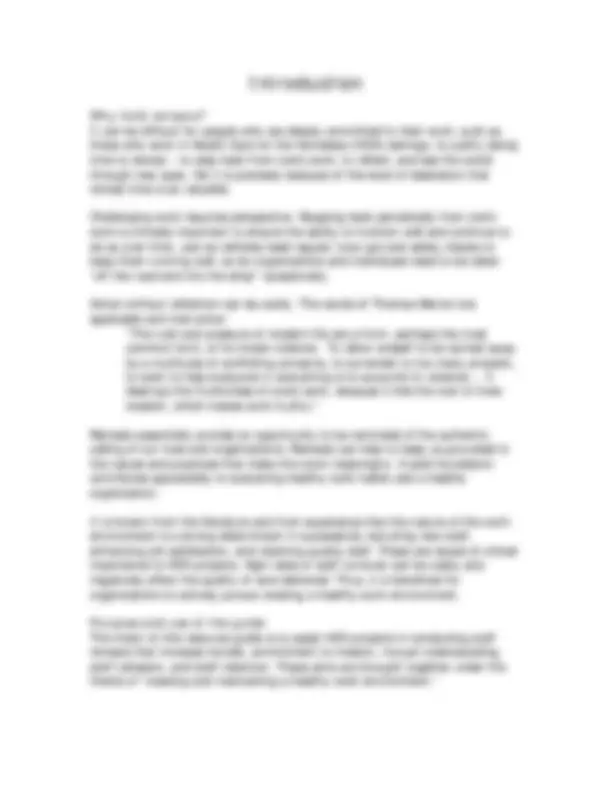

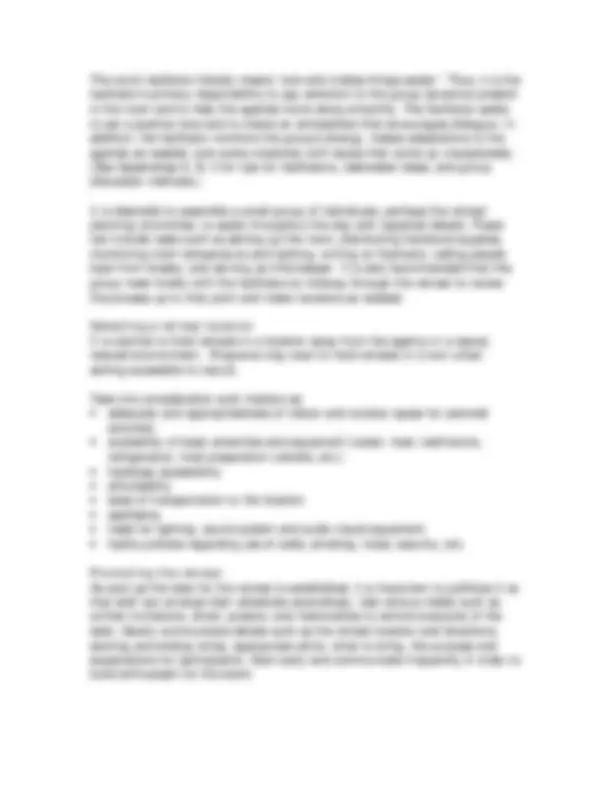
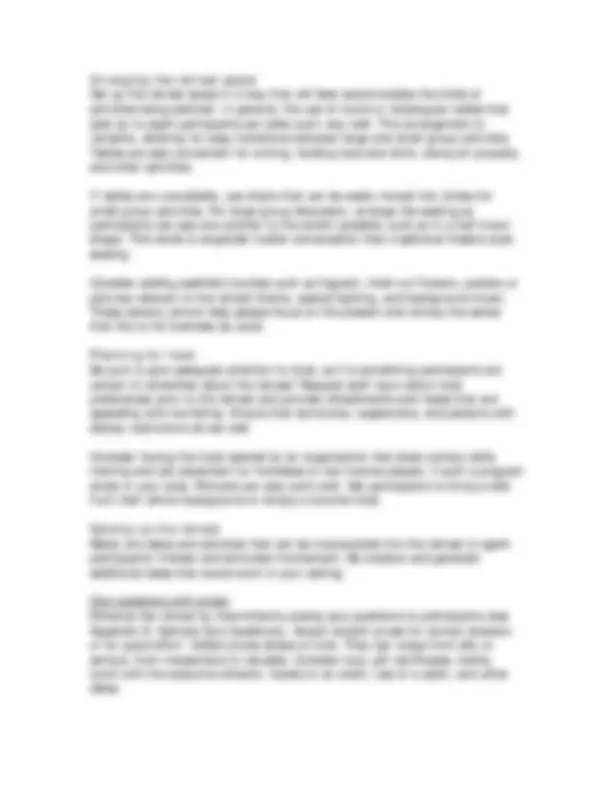
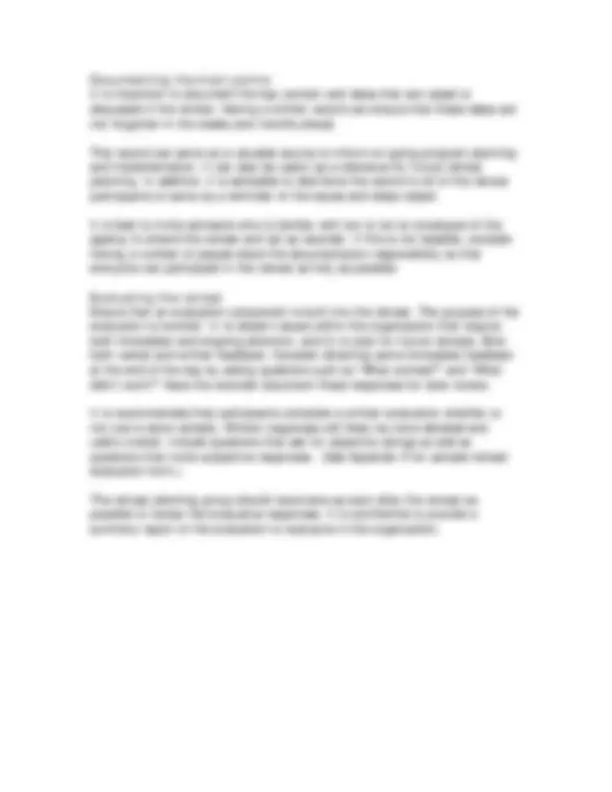
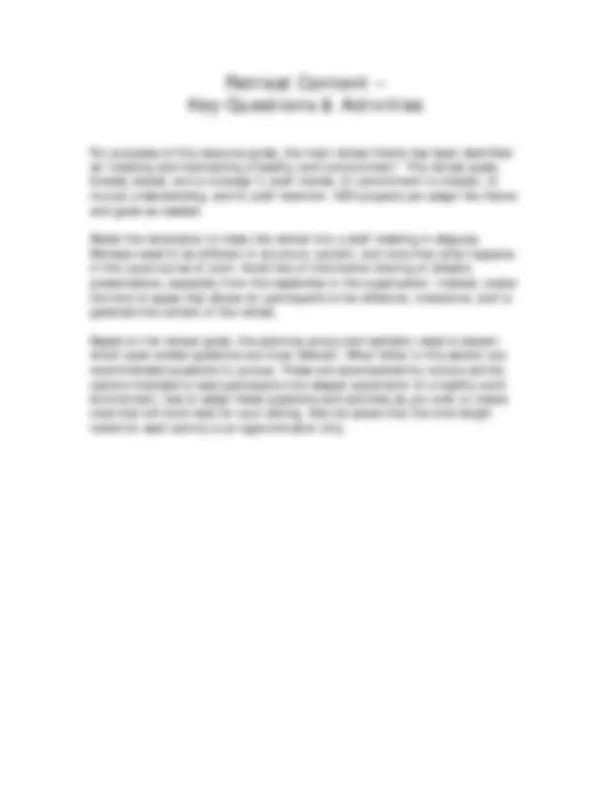
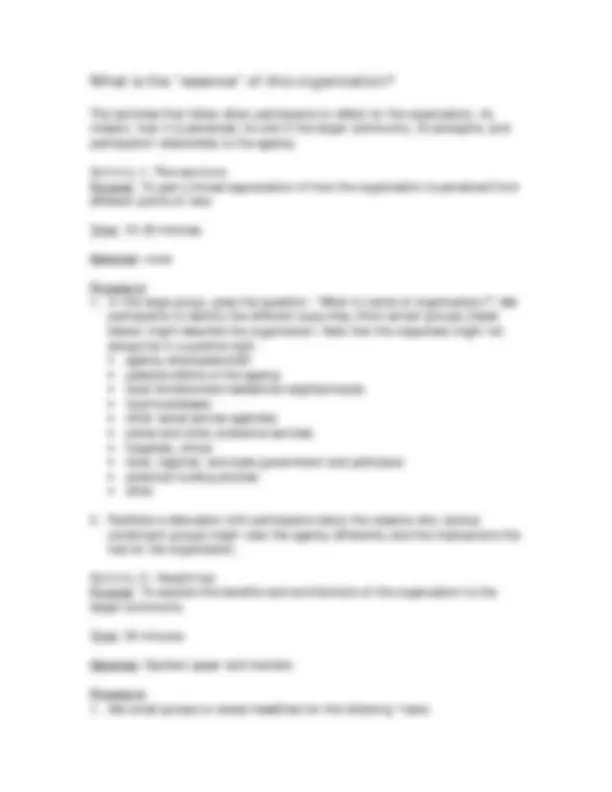
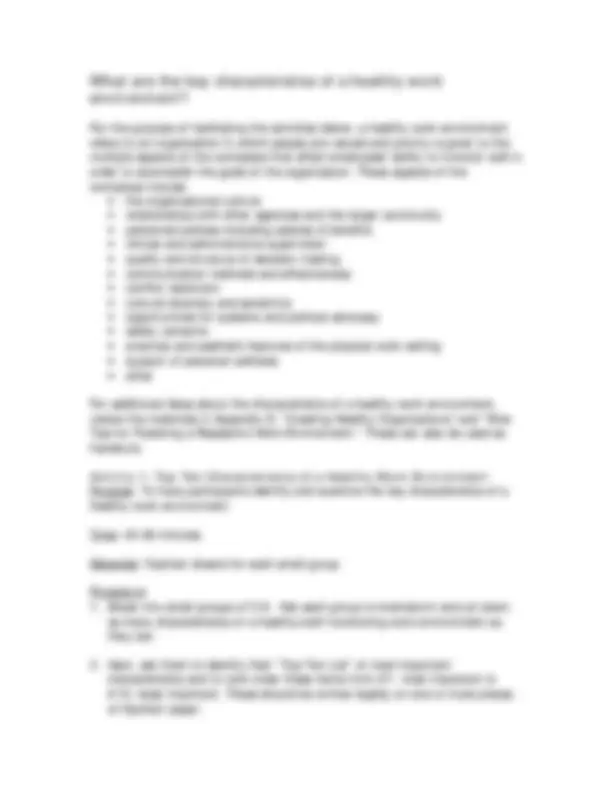
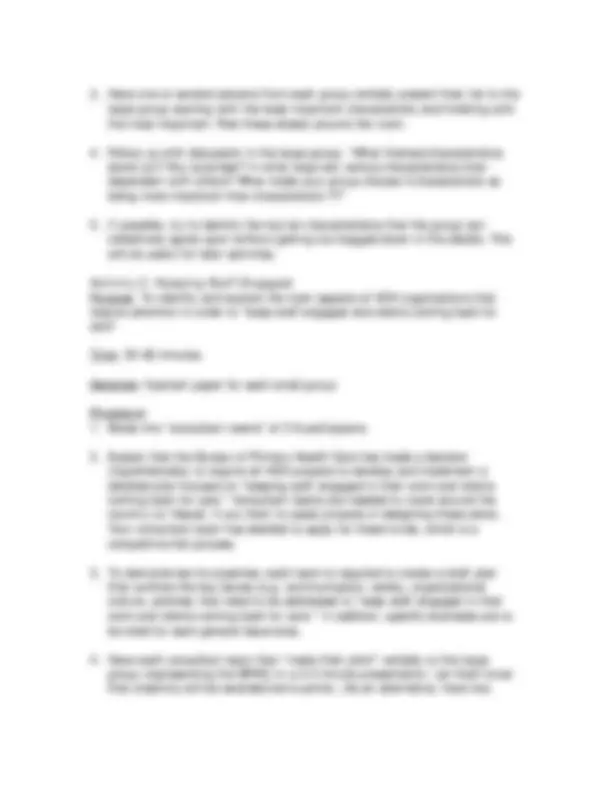
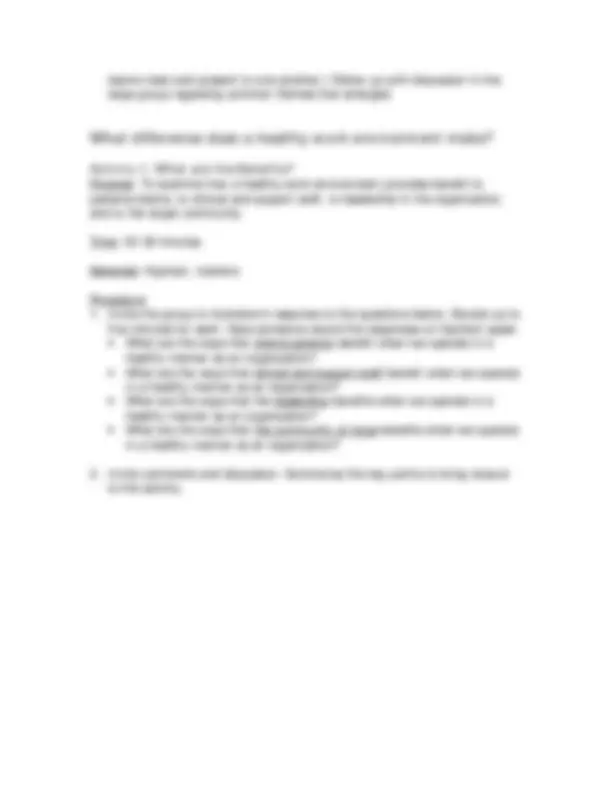
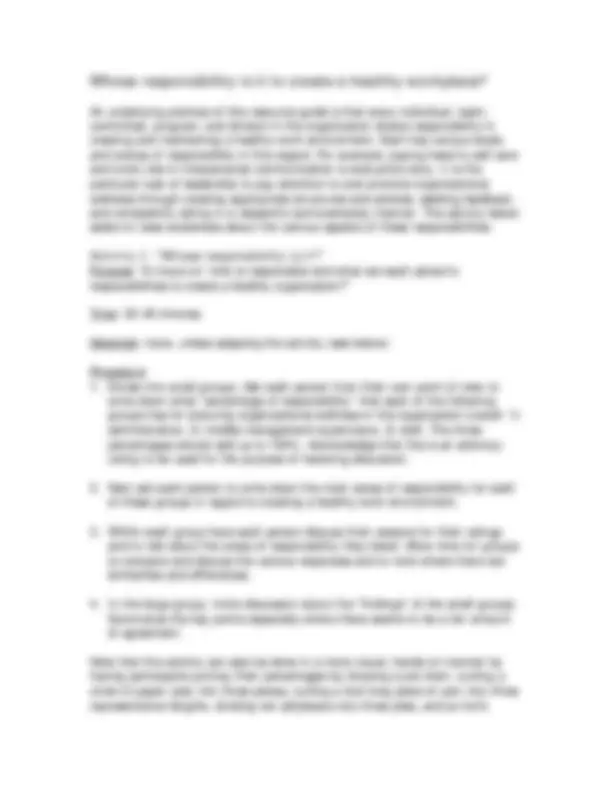
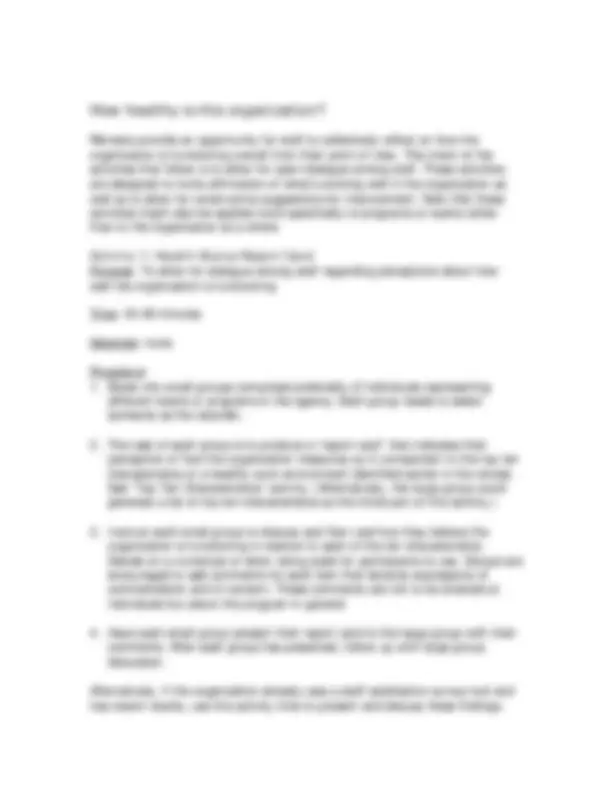
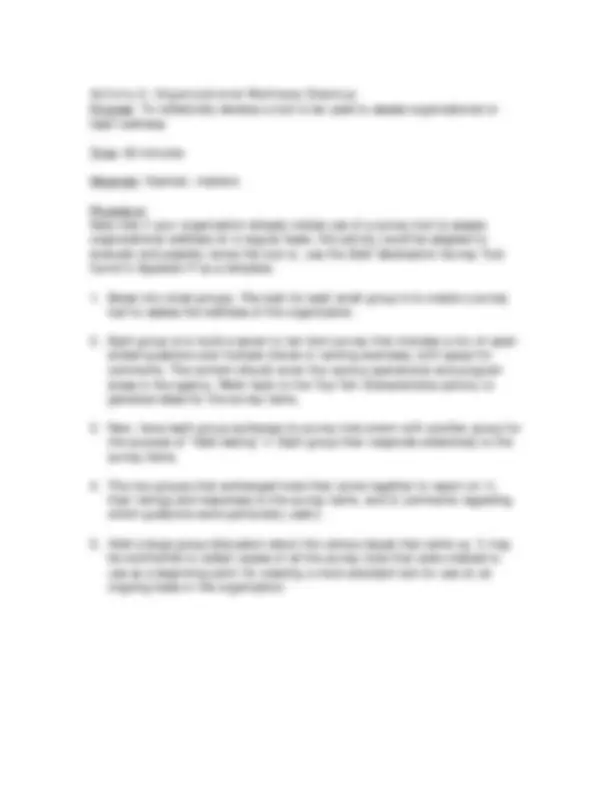
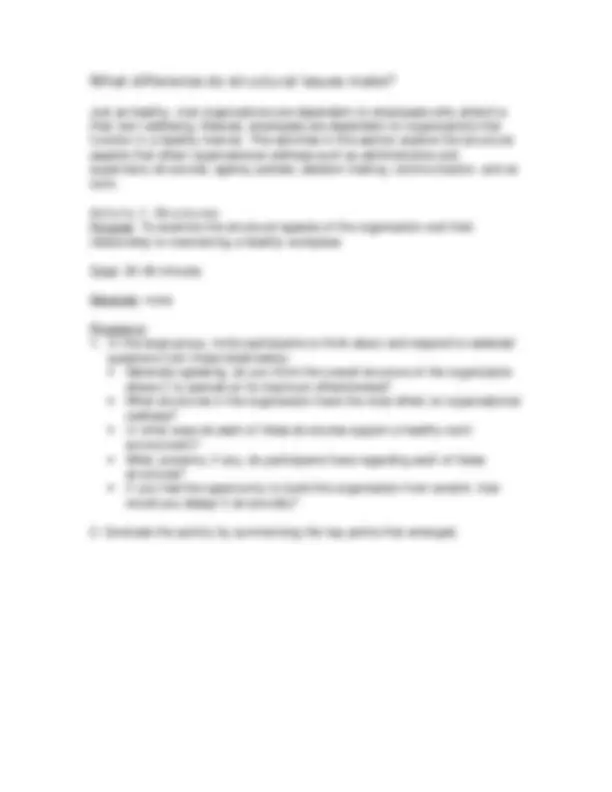
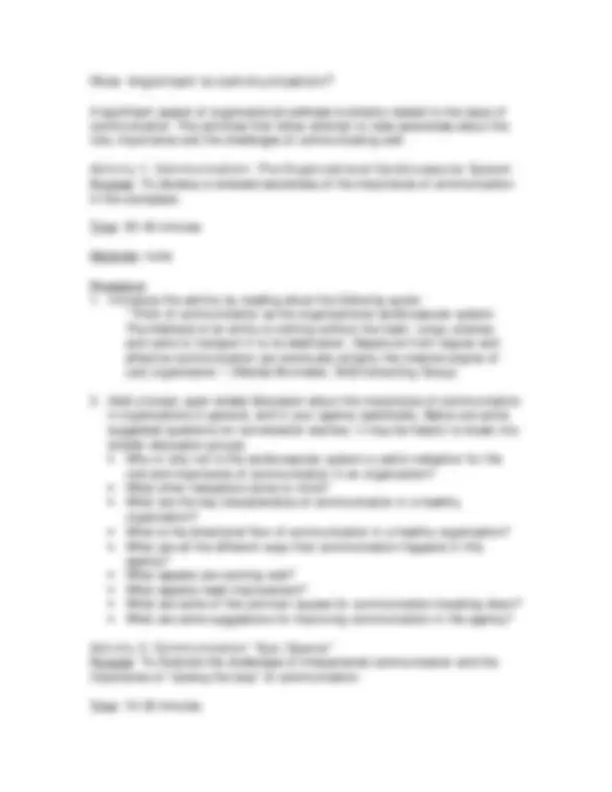
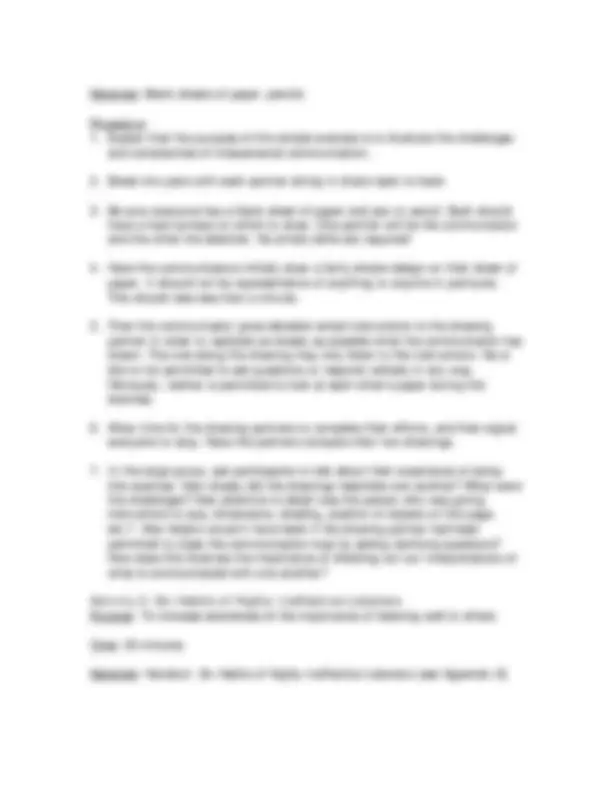
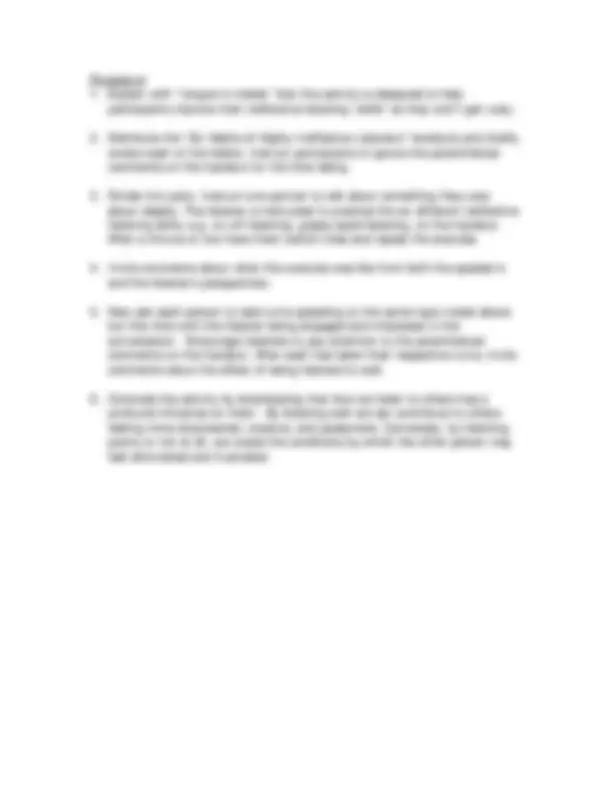
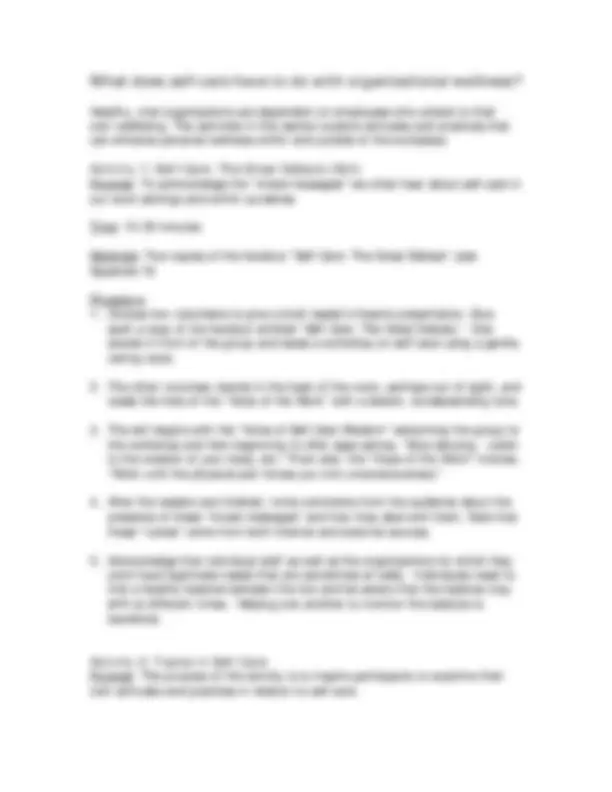
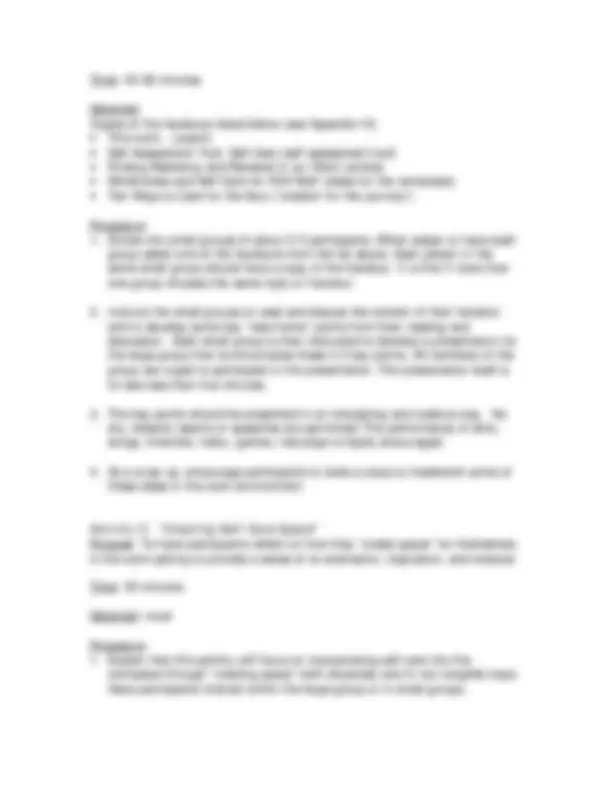
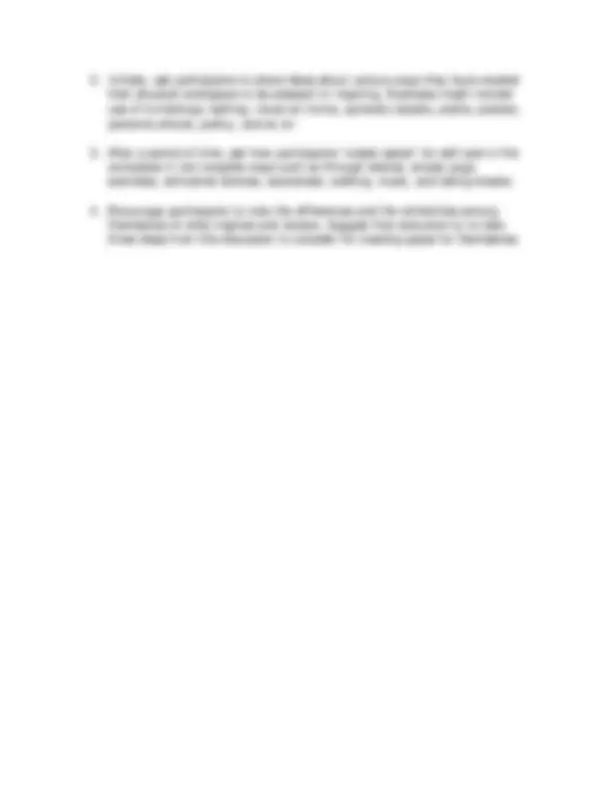
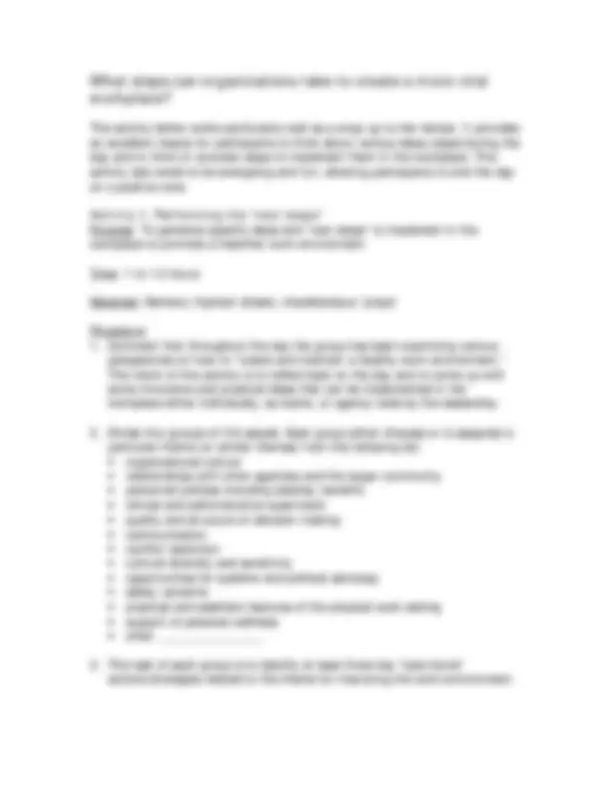
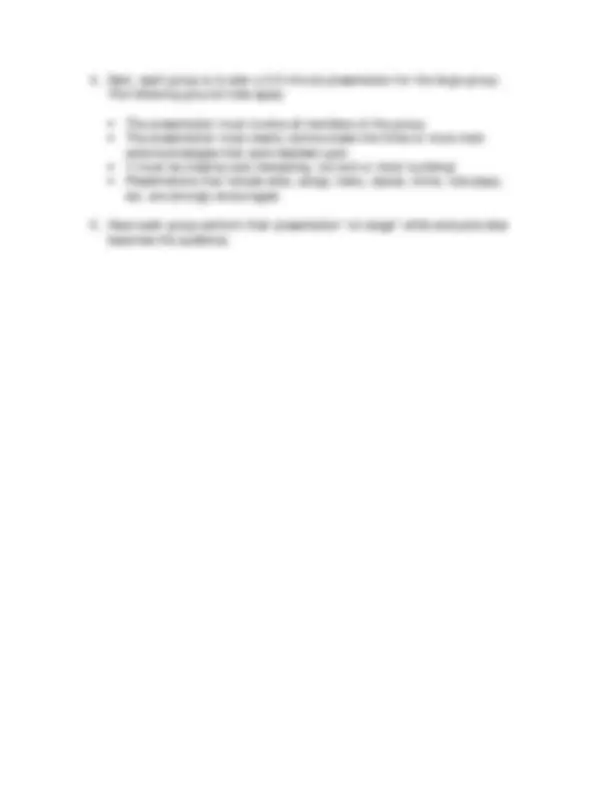

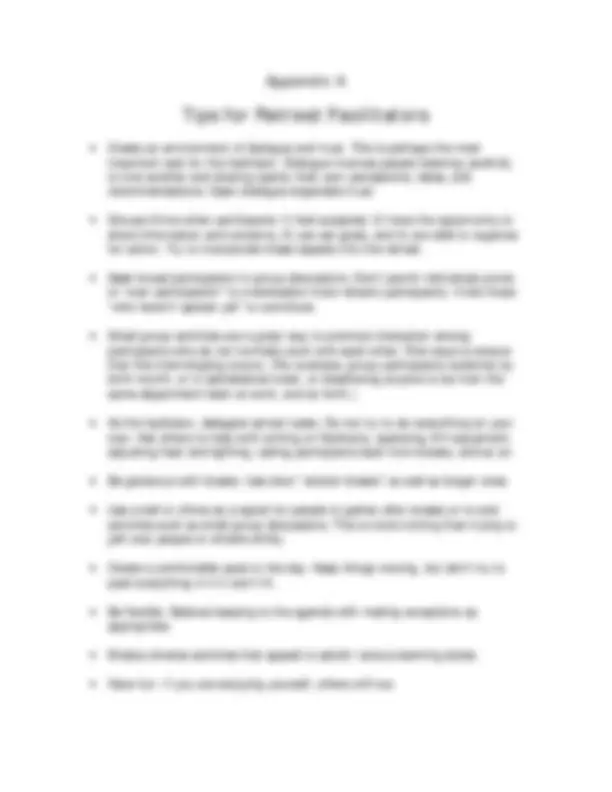
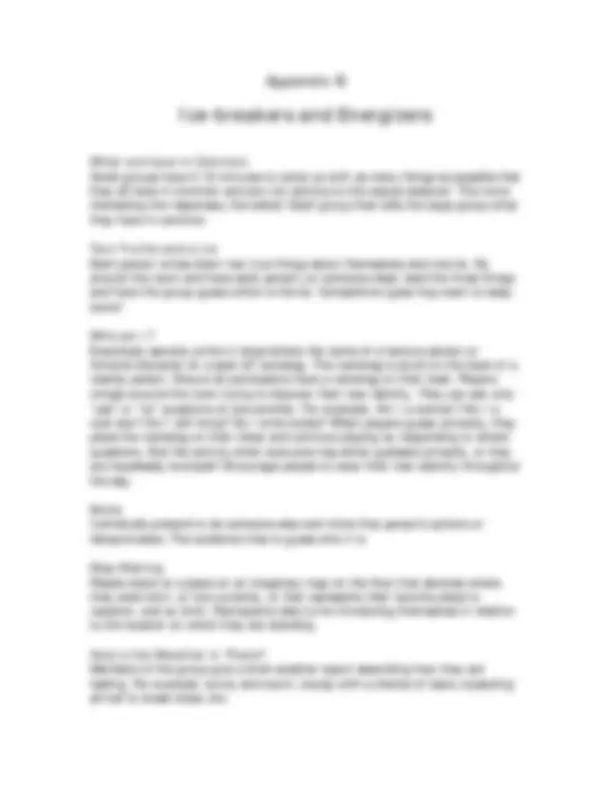
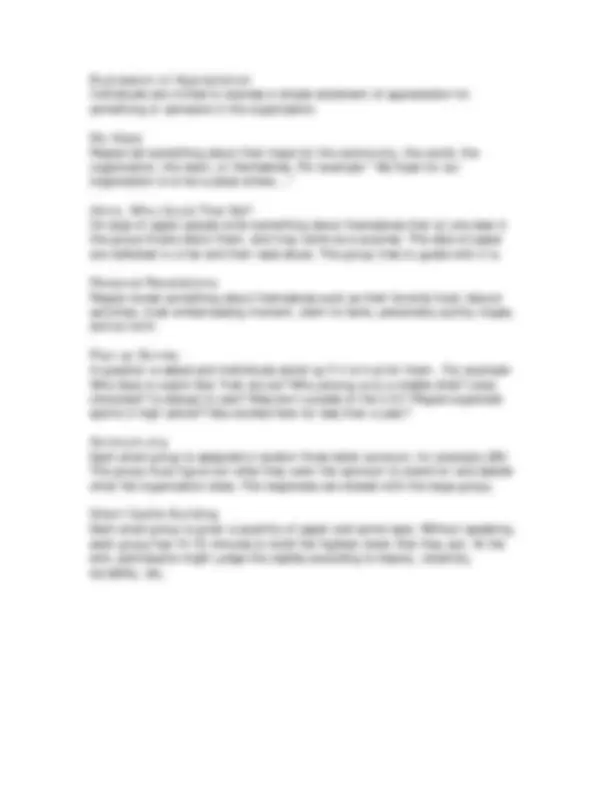
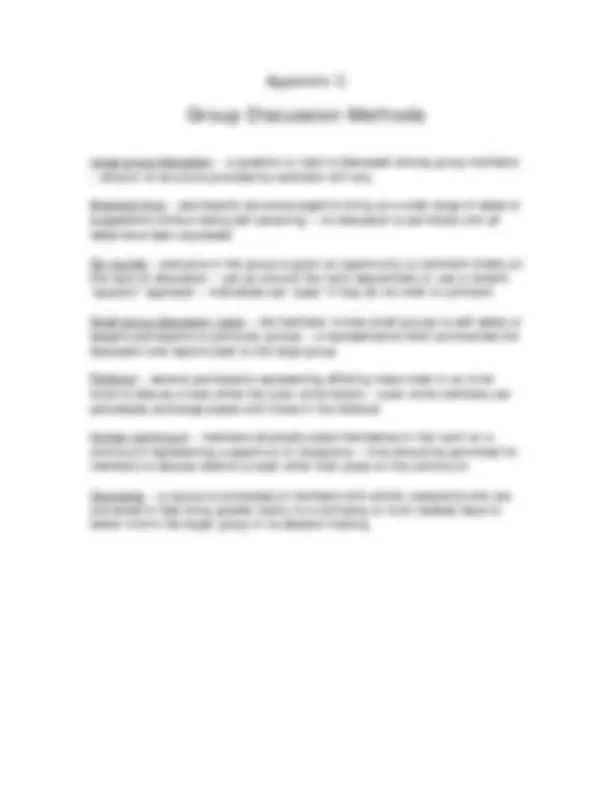
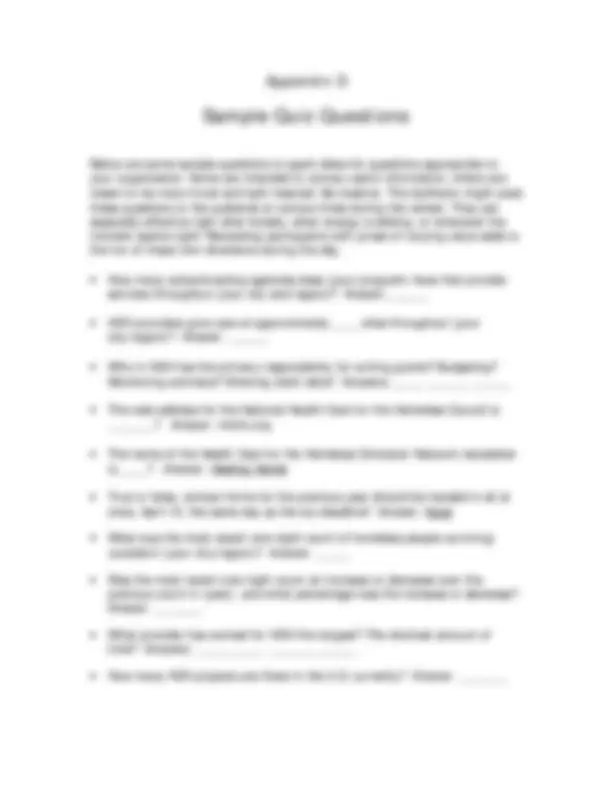
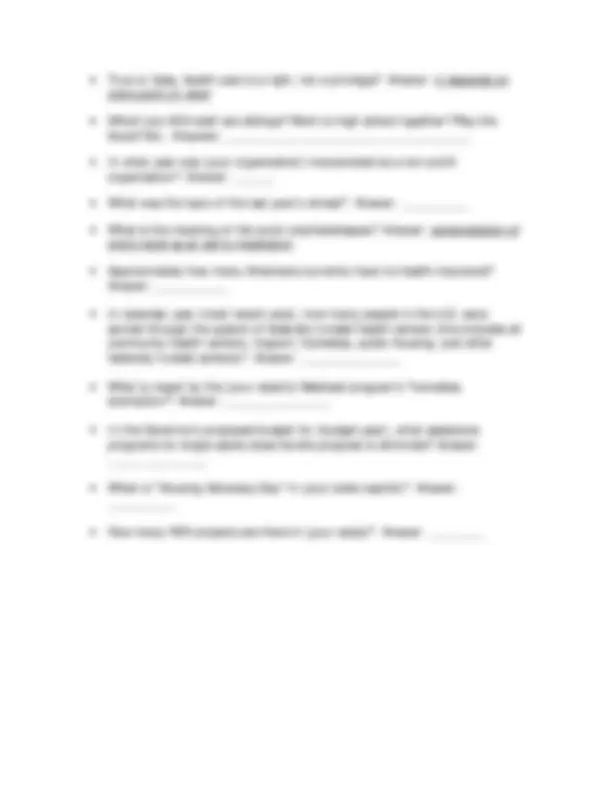
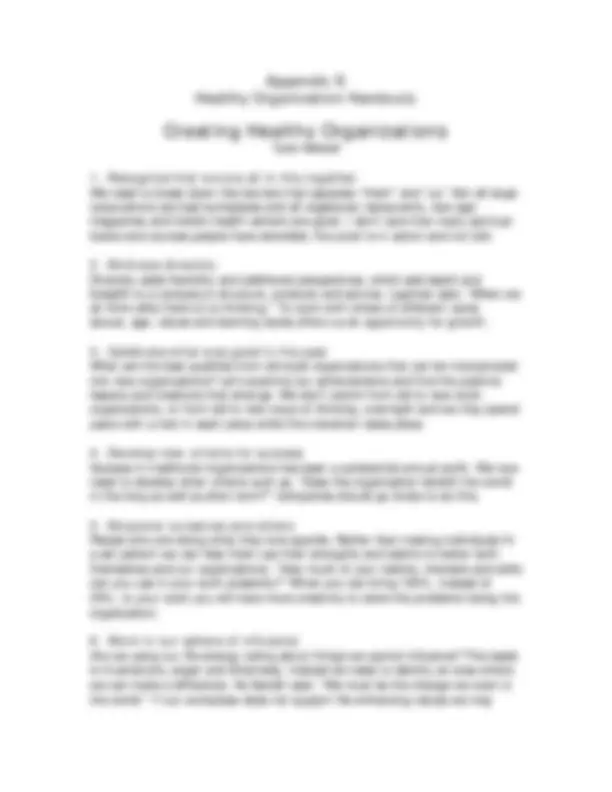
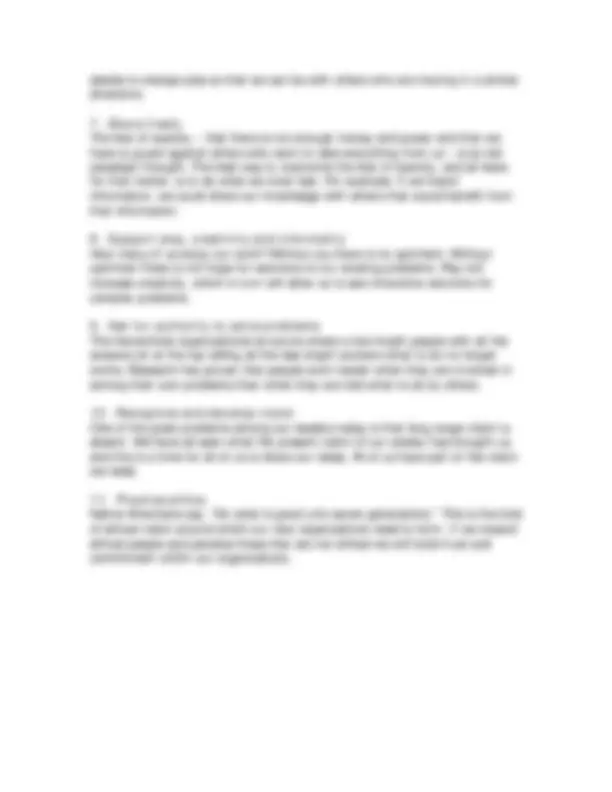
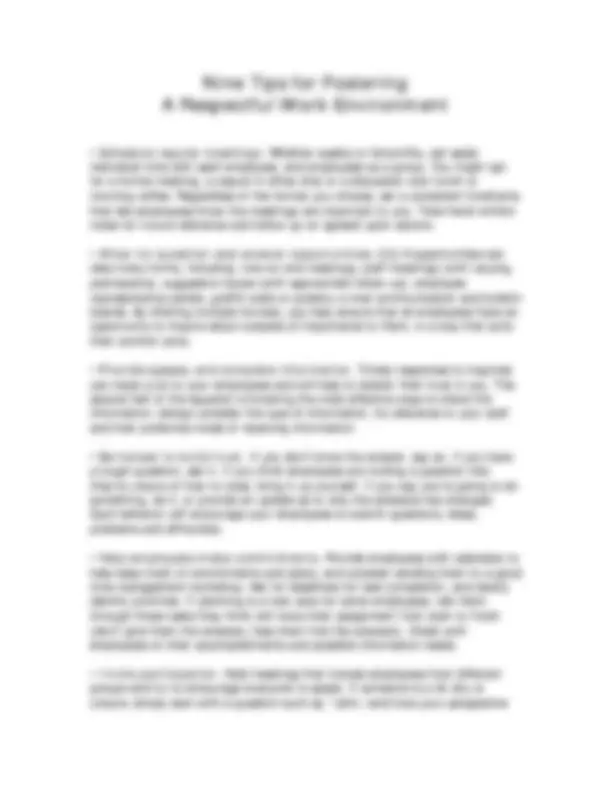
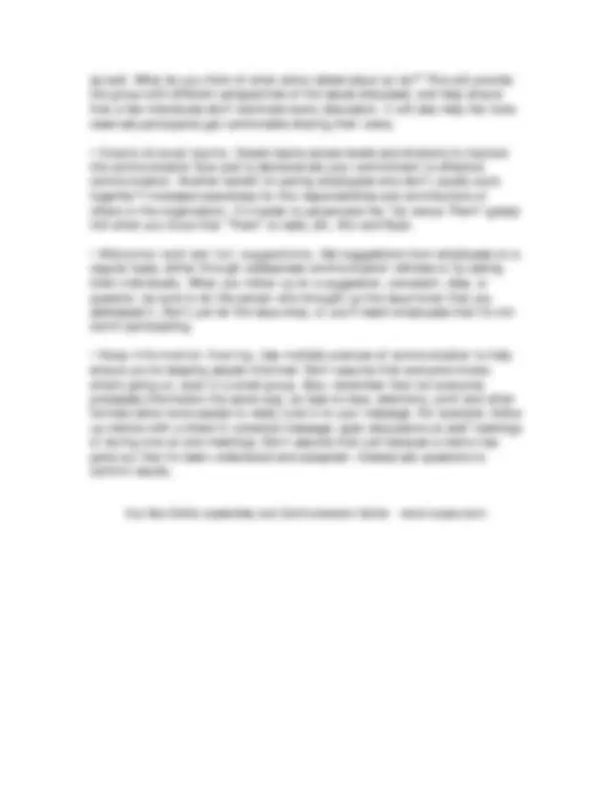
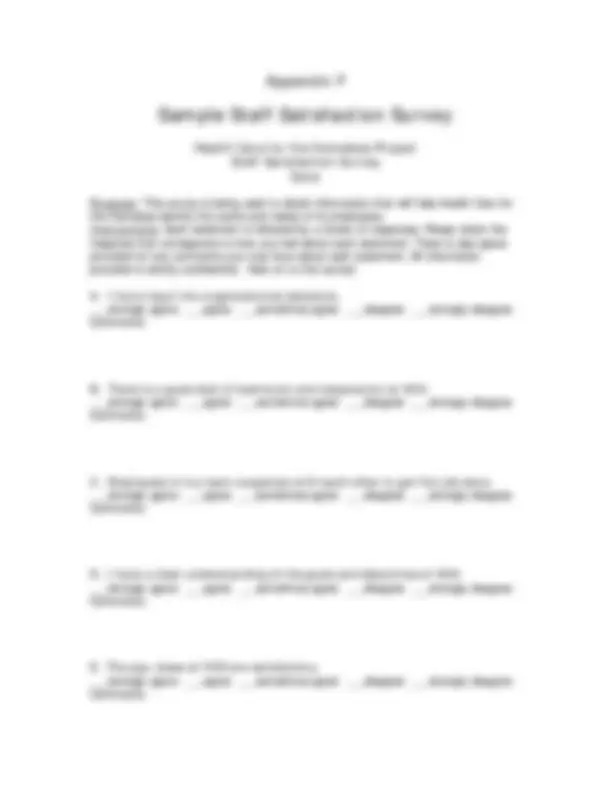
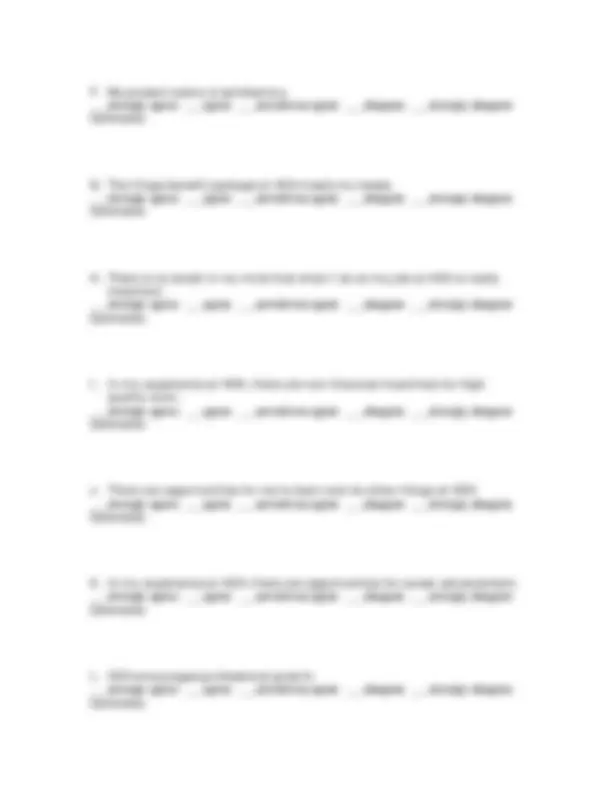
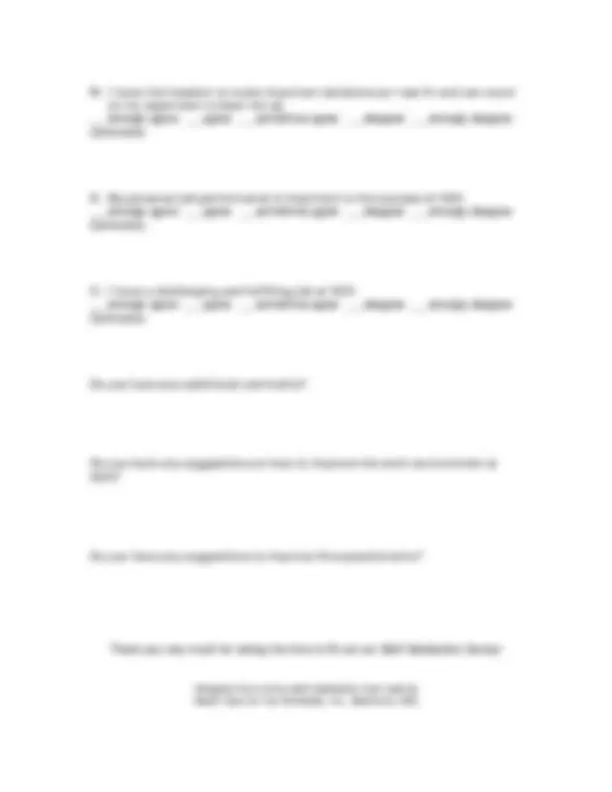
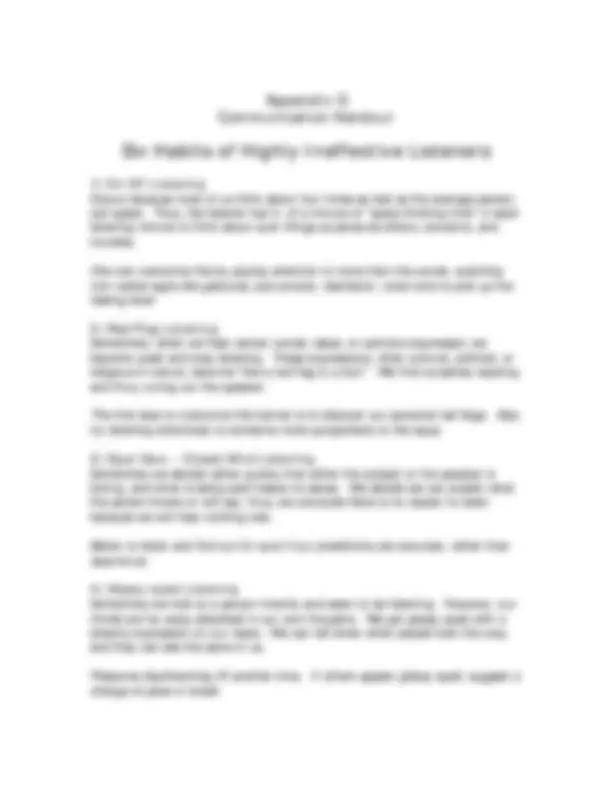
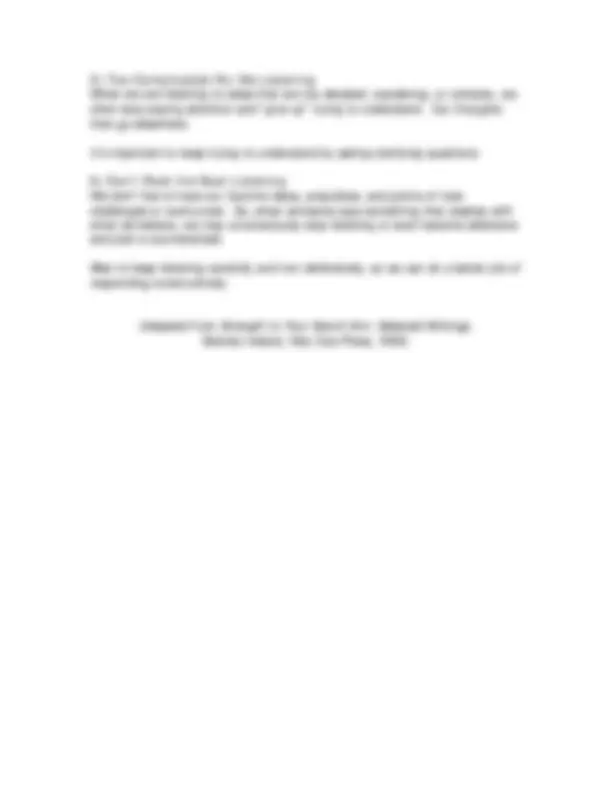
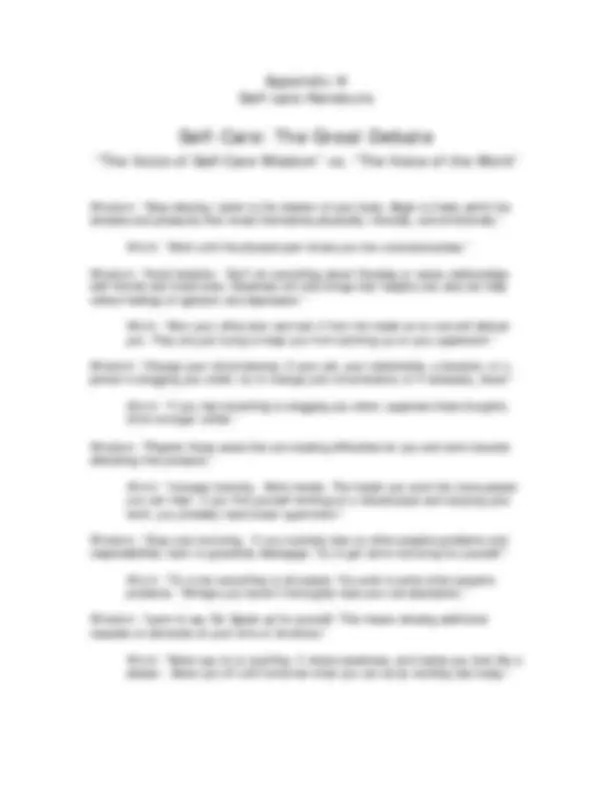
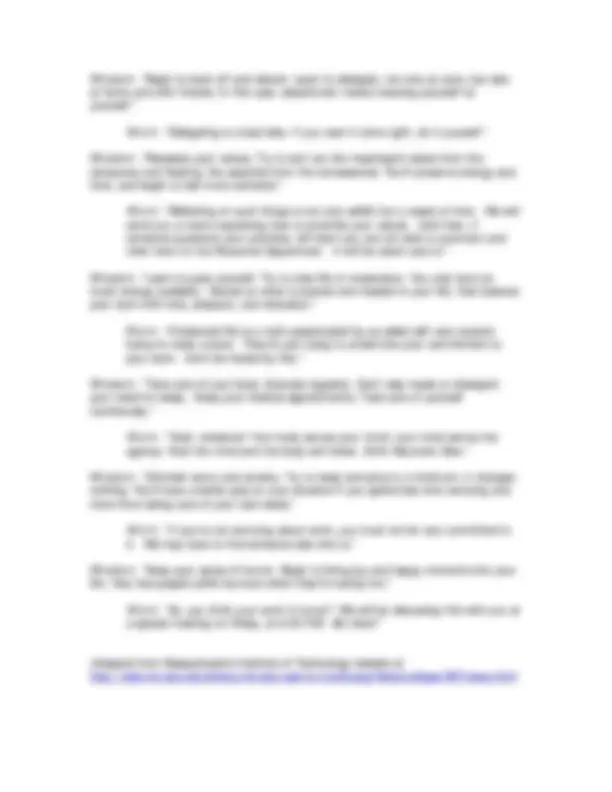

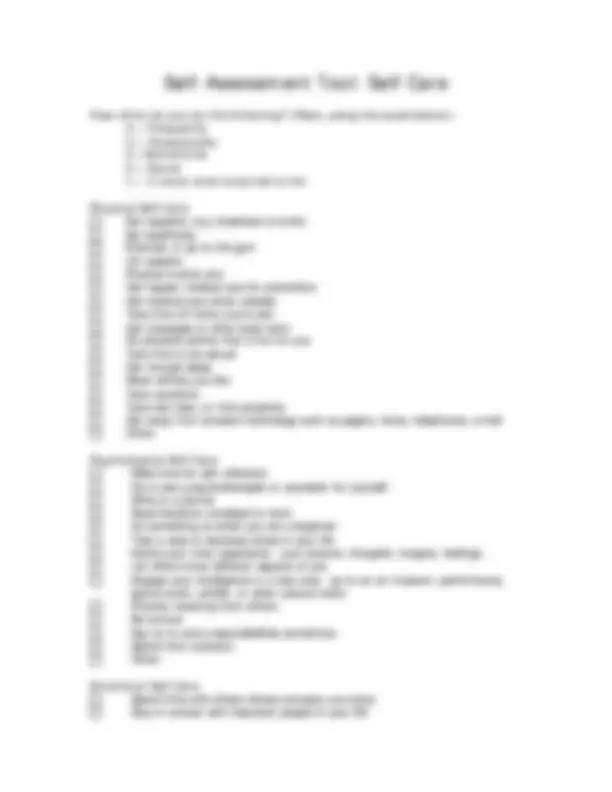
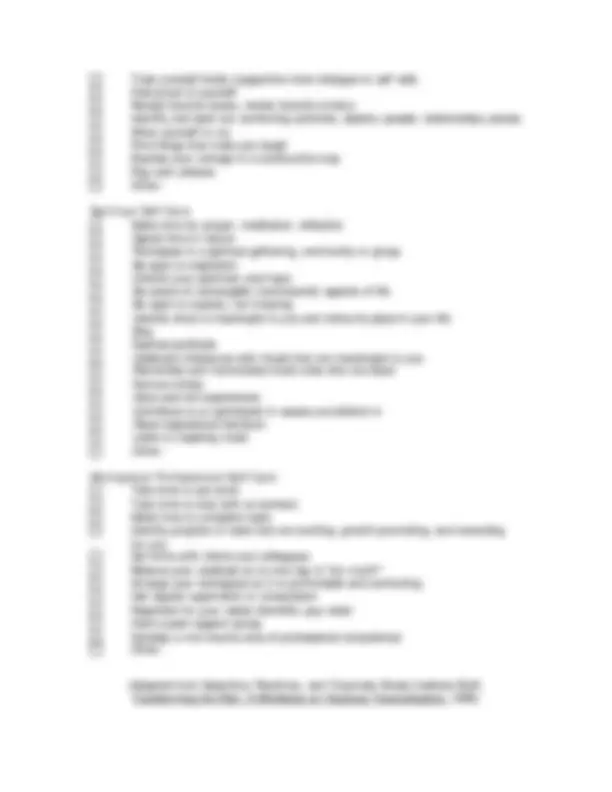
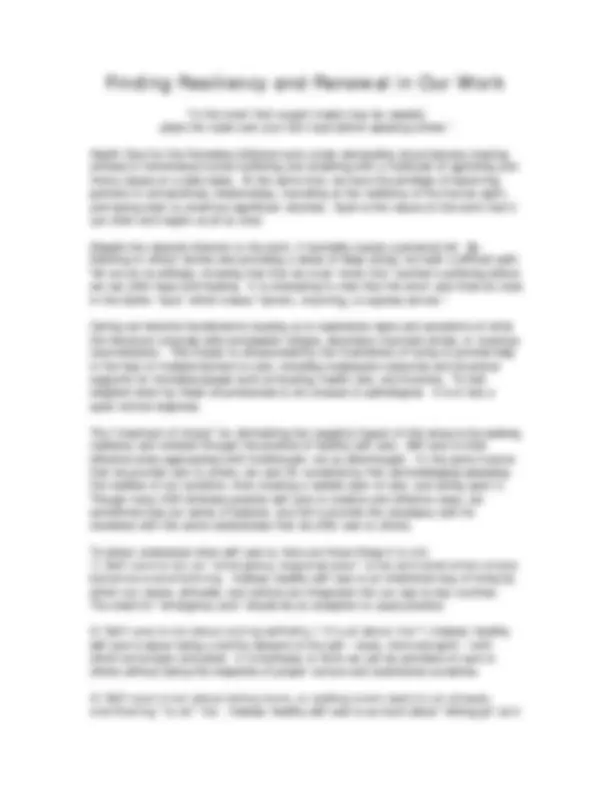
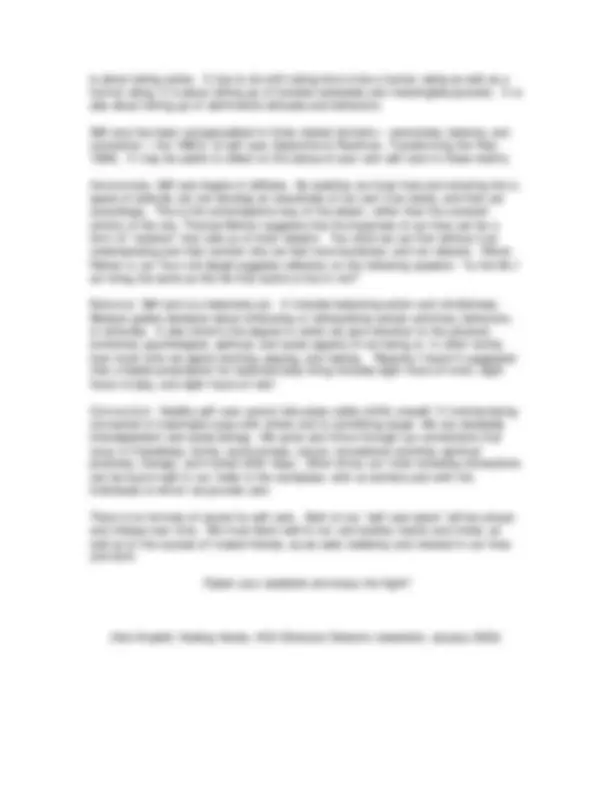
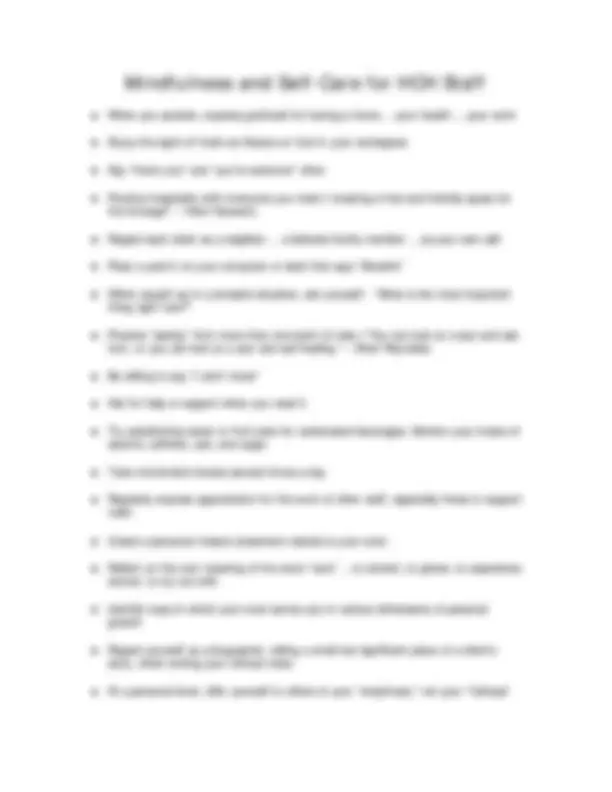
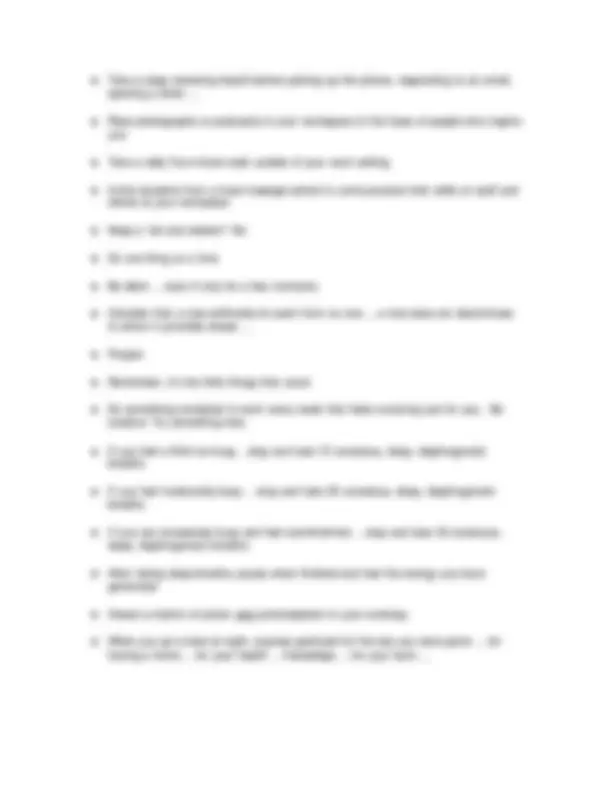
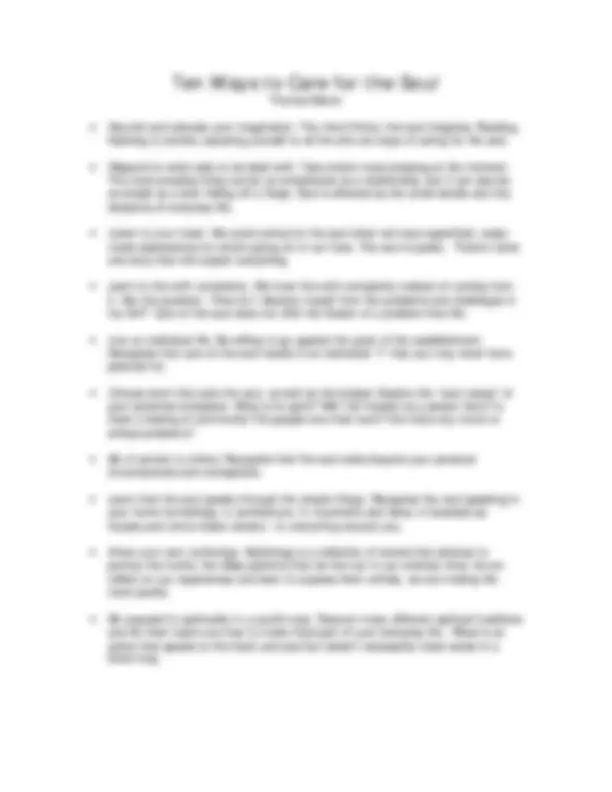
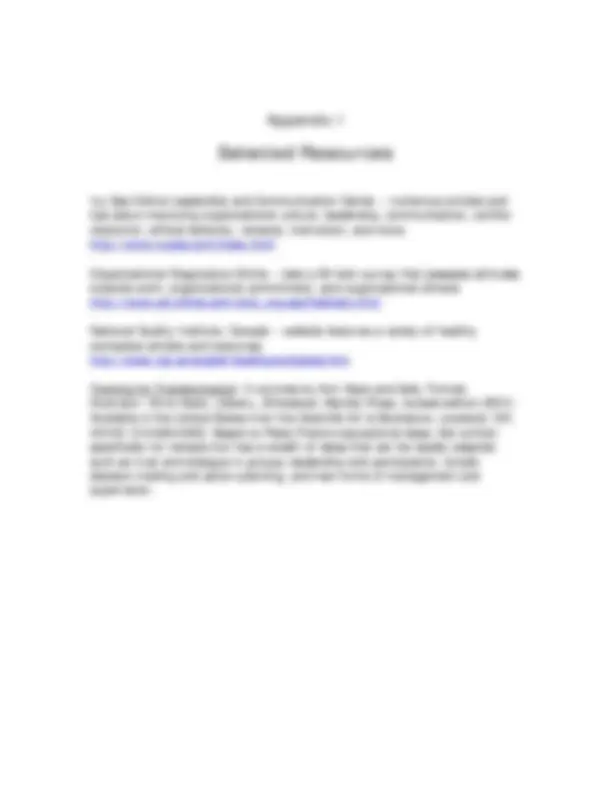
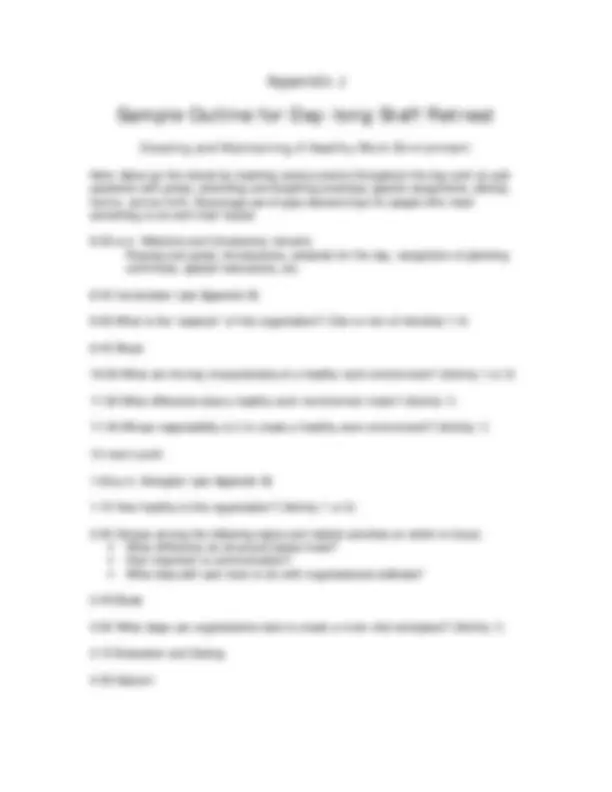
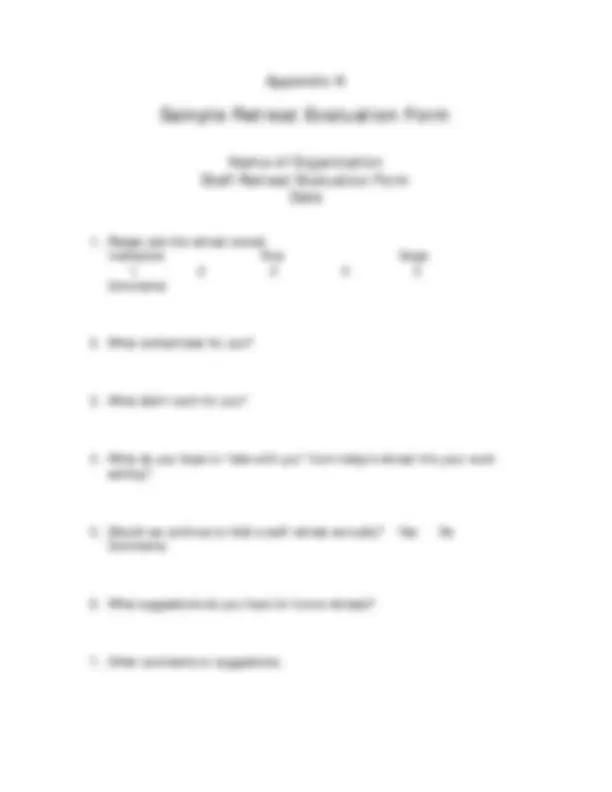


Study with the several resources on Docsity

Earn points by helping other students or get them with a premium plan


Prepare for your exams
Study with the several resources on Docsity

Earn points to download
Earn points by helping other students or get them with a premium plan
Community
Ask the community for help and clear up your study doubts
Discover the best universities in your country according to Docsity users
Free resources
Download our free guides on studying techniques, anxiety management strategies, and thesis advice from Docsity tutors
This resource guide provides practical ideas and activities for conducting staff retreats in healthcare organizations. The goal is to increase morale, commitment to mission, mutual understanding, staff cohesion, and staff retention. The guide is intended for administrators, team leaders, and retreat planning groups in HCH projects, but the concepts have broad applicability to other settings and organizations.
Typology: Lecture notes
1 / 61

This page cannot be seen from the preview
Don't miss anything!






















































Ken Kraybill, MSW National Health Care for the Homeless Council Health Care for the Homeless Clinicians’ Network
This project was supported through a grant from the Health Resources and Services Administration, U.S. Department of Health and Human Services May 2003
“… the elements that define a healthy work environment [include] collegiality and sharing; recognizing employees’ contributions; having policies that are based on trust; doing what we say we will do, both individually and as an organization; [and] encouraging employees to have a balanced life.”
Report on key findings from the Association of Professional Executives of the Public Service of Canada (APEX) colloquium entitled “Beyond the Talk: Achieving a healthy and productive work environment,” 1999
“ Think of communication as the organizational cardiovascular system. The lifeblood of an entity is nothing without the heart, lungs, arteries and veins to transport it to its destination. Departure from regular and effective communication can eventually atrophy the creative engine of [an organization].”
Wanda Shumaker, WJS Consulting Group
“ … surveys suggest that the main source of stress in the workplace, at every level of the organization, is interpersonal relationships … studies further indicate that the two most important factors that make staff feel positive about their work environment are the respect they are given and the recognition of their contribution in the workplace.”
Ron Sparrow, Vice President, Source Line Corporate Wellness Services Inc.
The impetus for this project grew out of Health Care for the Homeless Clinicians’ Network Steering Committee discussions over the past number of years. Various Network members, National Health Care for the Homeless Council staff, and other individuals have provided creative ideas and valuable assistance in developing this resource guide. In particular, I wish to thank Lisa Cunningham Roberts, Jenny Metzler, Jeff Olivet, Ruth Needham, Rachel Rodriguez-Marzec, Betty Schulz, Janna Wilson, Jeff Singer, Tom Lorello, Jen Holzwarth, Brenda Proffitt, and John Lozier for their contributions.
Special thanks to Health Care for the Homeless, Inc. in Baltimore and the Seattle Health Care for the Homeless Network for inviting me to facilitate all-staff retreats for their projects. These experiences permitted me to refine many of the themes and activities found in this guide.
A particular resource I have found valuable in developing this guide is Training for Transformation (revised edition 2001), written by Ann Hope and Sally Timmel, illustrated by Chris Hodzi, published by Mambo Press, Gweru, Zimbabwe. It is available in the United States from the Grailville Art & Bookstore, Loveland, OH, 45140; 513-683-0202. I am appreciative of such resources that stretch my thinking and spark creative ideas.
Finally, thank you to Jean Hochron and others at the Bureau of Primary Health Care, Health Resources and Services Administration, U.S. Department of Health and Human Services, for promoting and providing financial support for the development of this resource guide.
Why hold retreats? It can be difficult for people who are deeply committed to their work, such as those who work in Health Care for the Homeless (HCH) settings, to justify taking time to retreat – to step back from one’s work, to reflect, and see the world through new eyes. Yet it is precisely because of this level of dedication that retreat time is so valuable.
Challenging work requires perspective. Stepping back periodically from one’s work is critically important to ensure the ability to function well and continue to do so over time. Just as vehicles need regular tune-ups and safety checks to keep them running well, so do organizations and individuals need to be taken “off the road and into the shop” occasionally.
Action without reflection can be costly. The words of Thomas Merton are applicable and instructive: “The rush and pressure of modern life are a form, perhaps the most common form, of its innate violence. To allow oneself to be carried away by a multitude of conflicting concerns, to surrender to too many projects, to want to help everyone in everything is to succumb to violence … It destroys the fruitfulness of one’s work, because it kills the root of inner wisdom, which makes work fruitful.”
Retreats essentially provide an opportunity to be reminded of the authentic calling of our lives and organizations. Retreats can help to keep us grounded in the values and practices that make this work meaningful. A solid foundation contributes appreciably to sustaining healthy work habits and a healthy organization.
It is known from the literature and from experience that the nature of the work environment is a strong determinant in successfully recruiting new staff, enhancing job satisfaction, and retaining quality staff. These are issues of critical importance to HCH projects. High rates of staff turnover can be costly and negatively affect the quality of care delivered. Thus, it is beneficial for organizations to actively pursue creating a healthy work environment.
Purpose and use of the guide The intent of this resource guide is to assist HCH projects in conducting staff retreats that increase morale, commitment to mission, mutual understanding, staff cohesion, and staff retention. These aims are brought together under the theme of “creating and maintaining a healthy work environment.”
and offers tips for conducting successful retreats. This section also addresses retreat evaluation. The third section, Retreat Content – Key Questions and Activities , is the heart of the resource guide. The content is arranged around key questions for organizations to explore. Specific activity ideas are provided as a means to facilitate discussion of these questions. The materials in the Appendices provide resource information for the facilitator and can also be utilized as handouts.
Certain themes or activities may seem risky to use due to their potential for causing discomfort among participants. These topics should not necessarily be avoided. Exploring them is encouraged to unveil issues of importance or areas of inertia. This risk-taking could provide the necessary breakthrough to increase employees’ insight and understanding on the personal as well as the organizational levels. On the other hand, there are times when it will not be appropriate to broach controversial topics in the retreat context. The retreat planning group will need to make this discernment.
This section contains key considerations and action steps that will contribute to a successful retreat.
Convening a retreat planning committee Successful retreats require good planning. It is wise to convene a planning committee that begins its work four to six months in advance of the retreat. The committee should be comprised of members who represent the organization’s various programs and the staff’s diversity. Aim for a cross-section of agency staff who will bring different perspectives and creative ideas to the table. Generally, a group of six to eight members works well.
Determining retreat goals Ideally, everyone in the organization should have an opportunity to provide input into the focus of the retreat. Staff surveys are useful in this regard. Other means for gathering information include discussions in team meetings, individual conversations with staff, and soliciting feedback to draft proposals.
Below are sample questions to explore with agency staff and within the planning committee to shape the retreat agenda:
In addition to the organization’s leadership, it is the planning committee’s role to pose these questions and seek staff input. Ultimately, it is the planning committee’s responsibility, in concert with the facilitator, to specify the agenda, activities, and process for the retreat itself. (See Appendix I for selected resources and Appendix J for a sample outline for a daylong retreat.)
Choosing a facilitator A critical early decision in the planning process is to determine who will facilitate the retreat. This might be an individual or a team who share the facilitation role.
Arranging the retreat space Set up the retreat space in a way that will best accommodate the kinds of activities being planned. In general, the use of round or rectangular tables that seat six to eight participants per table work very well. This arrangement is versatile, allowing for easy transitions between large and small group activities. Tables are also convenient for writing, holding food and drink, doing art projects, and other activities.
If tables are unavailable, use chairs that can be easily moved into circles for small group activities. For large group discussion, arrange the seating so participants can see one another to the extent possible, such as in a half-moon shape. This tends to engender livelier conversation than traditional theatre style seating.
Consider adding aesthetic touches such as fragrant, fresh-cut flowers, posters or pictures relevant to the retreat theme, special lighting, and background music. These sensory stimuli help people focus on the present and convey the sense that this is not business as usual.
Planning for food Be sure to give adequate attention to food, as it is something participants are certain to remember about the retreat! Request staff input about food preferences prior to the retreat and provide refreshments and meals that are appealing and nourishing. Ensure that carnivores, vegetarians, and persons with dietary restrictions all eat well.
Consider having the food catered by an organization that does culinary skills training and job placement for homeless or low-income people, if such a program exists in your area. Potlucks can also work well. Ask participants to bring a dish from their ethnic background or simply a favorite food.
Spicing up the retreat Below are ideas and activities that can be incorporated into the retreat to spark participants’ interest and stimulate involvement. Be creative and generate additional ideas that would work in your setting.
Quiz questions with prizes Enhance the retreat by intermittently posing quiz questions to participants (see Appendix D: Sam ple Quiz Questions). Award random prizes for correct answers or for good effort. Collect prizes ahead of time. They can range from silly to serious, from inexpensive to valuable. Consider toys, gift certificates, books, lunch with the executive director, tickets to an event, use of a cabin, and other ideas.
Outside recognitions Request community leaders or government officials from your city, county, region, or state to officially recognize and express appreciation for your organization’s work. Invite them to come to the retreat to deliver their statement in person. Ask for a printed certificate or proclamation that can be displayed in your agency. A copy can also be given to each staff person.
Allow plenty of lead time to negotiate the bureaucracy to obtain these recognitions. Be prepared to provide the basic script. Consider inviting the media and sending a press release regarding any outside recognitions.
In-house recognitions Healthy organizations tend to foster an environment in which recognition and gratitude is freely expressed. They regularly take opportunities to publicly recognize staff and volunteers for high quality work, meeting program goals, special accomplishments, providing assistance on special projects, for significant personal events and milestones, and so forth.
Retreats provide an excellent venue for providing public recognition. These expressions can be given verbally or perhaps accompanied with a tangible certificate or award. Though it is often the domain of administrators to offer recognitions, they can rightfully be provided by anyone in the organization.
Healthy organizations also create space for employees to extend recognition and support to others who might be facing illness, a personal or family crisis, or other stressful circumstances. While not always appropriate to do so publicly, it is often helpful to acknowledge such events with the employee’s permission to do so.
Pipe cleaners, finger puppets, and squiggly things Provide a supply of different colored pipe cleaners and small, non-noise-making toys to give participants something to do with their hands. Paradoxically, this helps many people maintain attention throughout the course of the day. Pipe cleaners are especially fun and are inexpensive. Explain that these toys have no particular purpose other than for participants to amuse themselves.
Silence Consider incorporating one or more periods of silence into the retreat agenda. This can be an effective way for participants to focus their attention and energy, “let go” of distractions, take calming breaths, and set or maintain a positive tone. Herman Melville wrote, “All profound things and emotions of things are preceded and attended by silence.”
Sitting in silence as a group may be an unusual experience for many people. It can be a rather powerful experience but also unsettling, often at the same time.
Documenting the main points It is important to document the key content and ideas that are raised or discussed in the retreat. Having a written record can ensure that these ideas are not forgotten in the weeks and months ahead.
This record can serve as a valuable source to inform on-going program planning and implementation. It can also be useful as a reference for future retreat planning. In addition, it is advisable to distribute the record to all of the retreat participants to serve as a reminder of the issues and ideas raised.
It is best to invite someone who is familiar with but is not an employee of the agency to attend the retreat and act as recorder. If this is not feasible, consider having a number of people share the documentation responsibility so that everyone can participate in the retreat as fully as possible.
Evaluating the retreat Ensure that an evaluation component is built into the retreat. The purpose of the evaluation is twofold: 1) to discern issues within the organization that require both immediate and ongoing attention, and 2) to plan for future retreats. Elicit both verbal and written feedback. Consider obtaining some immediate feedback at the end of the day by asking questions such as “What worked?” and “What didn’t work?” Have the recorder document these responses for later review.
It is recommended that participants complete a written evaluation whether or not one is done verbally. Written responses will likely be more detailed and useful overall. Include questions that ask for objective ratings as well as questions that invite subjective responses. (See Appendix K for sample retreat evaluation form.)
The retreat planning group should reconvene as soon after the retreat as possible to review the evaluative responses. It is worthwhile to provide a summary report of the evaluation to everyone in the organization.
For purposes of this resource guide, the main retreat theme has been identified as “creating and maintaining a healthy work environment.” The retreat goals, broadly stated, are to increase 1) staff morale, 2) commitment to mission, 3) mutual understanding, and 4) staff retention. HCH projects can adapt the theme and goals as needed.
Resist the temptation to make the retreat into a staff meeting in disguise. Retreats need to be different in structure, content, and tone than what happens in the usual course of work. Avoid lots of information sharing or didactic presentations, especially from the leadership in the organization. Instead, create the kind of space that allows for participants to be reflective, interactive, and to generate the content of the retreat.
Based on the retreat goals, the planning group and facilitator need to discern which open-ended questions are most relevant. What follow in this section are recommended questions to pursue. These are accompanied by various activity options intended to lead participants into deeper exploration of a healthy work environment. Use or adapt these questions and activities as you wish or create ones that will work best for your setting. Also be aware that the time length noted for each activity is an approximation only.
scenarios” in your city/region:
Activity 3: Wall of Wonder Purpose: To think about the organization from a “strengths-based” perspective – to identify the characteristics that staff appreciate most and are most proud of about the agency
Time: 30 minutes
Materials: index cards, different colored markers
Procedure:
Activity 4: Metaphors Purpose: To examine participants’ relationship to the agency using common objects as metaphors
Time: 30-45 minutes
Materials: none, except objects to be found by participants
Procedure:
(Adapted from an activity created by Jenny Metzler and Cheryl Gooding)
Activity 2: Keeping Staff Engaged Purpose: To identify and explore the main aspects of HCH organizations that require attention in order to “keep staff engaged and clients coming back for care”
Time: 30-60 minutes
Materials: flipchart paper for each small group
Procedure:
teams meet and present to one another.) Follow up with discussion in the large group regarding common themes that emerged.
Activity 1: What are the Benefits? Purpose: To examine how a healthy work environment provides benefit to patients/clients, to clinical and support staff, to leadership in the organization, and to the larger community
Time: 20-30 minutes
Materials: flipchart, markers
Procedure: